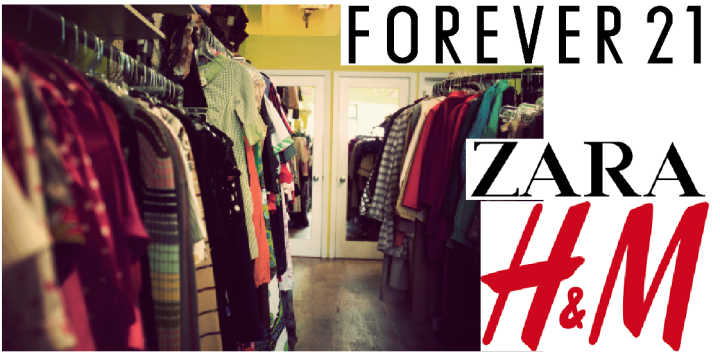By Samantha Rosen
Staff Writer
Fast fashion, mass-produced clothing that attracts consumers as a result of their affordability, gratifies the human’s constant need for new things. Yet with daily shipments to stores, supply chains of production, clothing construction and eventual disposal of the clothing, the fashion industry takes a toll on the environment.
Stores such as Zara, Forever 21 and H&M all contribute to the fast-fashion industry, providing clothes that can be worn while in-style seasonally, and be thrown out after. According to the Huffington Post, fast-fashion clothes “are cheap and look like your favorite designer clothes,” however those clothes are worn on average less than five times and are kept on average for only 35 days.

“I like shopping at Forever 21 because even though the quality isn’t amazing, it’s still very affordable, and I know that I’ll get use out of it,” sophomore hearing and speech major Carly Dauber said. “It’s better to buy more things for less money than less things for more money.”
Thrift store shopping, an alternative to fast fashion, remains inexpensive and provides consumers with a variety of fashion styles. Shopping locally at small stores or thrift stores, for example, encourages local employment as well as the reusing of clothes, decreasing the impact clothes production has on the environment.
However, many times people choose alternatives, such as online shopping, to make their lives easier, especially college students. This again adds to the environmental damage done in the retail business, as clothes are shipped from the warehouse to the consumer.
“I would rather buy cheaper clothes that are trendy, but if I’m wearing something nice, like a leather jacket, I would rather spend the money and get one that is going to last forever,” sophomore communications major Melanie Maltz said. “In addition to this, I tend to shop for trendy clothes online, which puts some of my favorite local stores out of business. It is just much easier to buy clothes online and send them to school, as opposed to going to a store and buying something.”
Not only are many thrift stores open to bargaining, making them cheaper, but they also keep more clothes out of landfills. In 2013, 15.1 million tons of textile waste was generated, of which 12.8 million tons were discarded, according to the Environmental Protection Agency. By buying clothes that others have already owned, there are less clothes being made and going through production, as well as less waste.
“Thrift shopping is good because there are so many options at a low price,” sophomore communications major Jacqueline Davis said. “My friend benefits from it because she buys so much for such a low cost, and she finds a lot of clothing that you might not find in a ‘normal store.’”
Different companies are experimenting with ways to create less waste and encourage reusable clothing. Rent The Runway, for example, rents branded clothes out to customers for a monthly fee. Similar companies include Lending Luxury and Girl Meets Dress.
“I really loved the idea of Rent the Runway because I feel like I am walking on the red carpet without the price tag,” sophomore communications major Juliana Demoraes said. “Whenever I have an important event, I’d rather not pay a ridiculous amount of money on something nice to only wear once. That’s why I always turn to Rent the Runway.”

